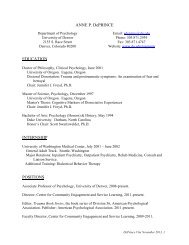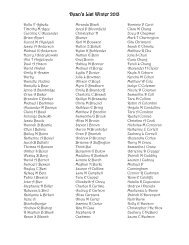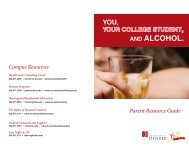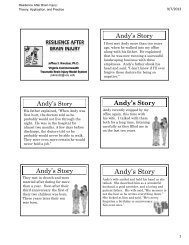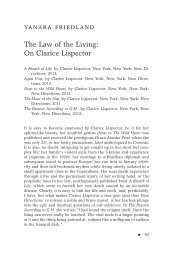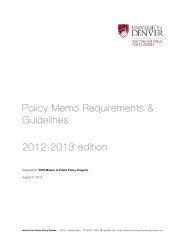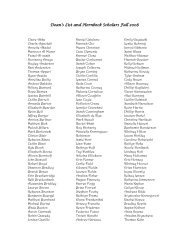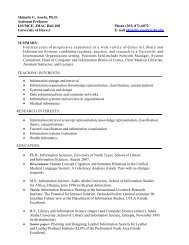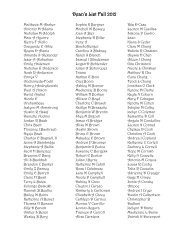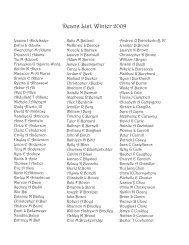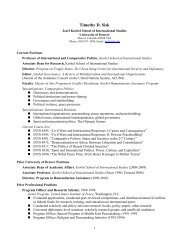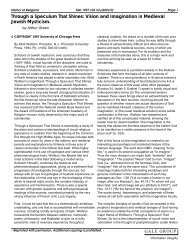Chien-Kai Chen, “China and Taiwan: A Future of Peace? A Study of ...
Chien-Kai Chen, “China and Taiwan: A Future of Peace? A Study of ...
Chien-Kai Chen, “China and Taiwan: A Future of Peace? A Study of ...
You also want an ePaper? Increase the reach of your titles
YUMPU automatically turns print PDFs into web optimized ePapers that Google loves.
Josef Korbel Journal <strong>of</strong> Advanced International Studies - 21<br />
cheap labor in China; however, <strong>Taiwan</strong>ese farmers <strong>and</strong> unskilled workers were worried about the<br />
import <strong>of</strong> cheap Chinese agricultural products <strong>and</strong> labor.<br />
Second, the political forces that emerged after the 2000 presidential election (Pan-Green<br />
supporting <strong>Taiwan</strong>ese identity <strong>and</strong> Pan-Blue supporting Chinese identity) exploited this cleavage.<br />
Although <strong>Chen</strong> Shui-Bian, a politician in Pan-Green, dropped the “don’t haste, be patient” policy<br />
<strong>and</strong> introduced the “active openness <strong>and</strong> effective management” policy, he refused the request<br />
for more openness because he believed that <strong>Taiwan</strong>’s growing asymmetrical economic<br />
dependence on China might have a negative effect on <strong>Taiwan</strong>’s national security. Losing the<br />
support from <strong>Taiwan</strong>ese businesspeople in China including those who supported him in 2000,<br />
<strong>Chen</strong> Shui-Bain <strong>and</strong> Pan-Green politicians began to appeal directly to those who were not<br />
benefiting from the growing China-<strong>Taiwan</strong> economic ties. At the same time, Pan-Blue, arguing<br />
that the growing economic ties between China <strong>and</strong> <strong>Taiwan</strong> would benefit <strong>Taiwan</strong>’s economic<br />
development, advocated more openness between China <strong>and</strong> <strong>Taiwan</strong> <strong>and</strong> began to appeal directly<br />
to those who were benefiting from the growing economic ties across the <strong>Taiwan</strong>-Strait. In<br />
addition, the fact that China had a much more friendly attitude towards Pan-Blue due to its<br />
support for Chinese identity made those who had economic interests in China more willing to<br />
vote for Pan-Blue in elections because they believed that a Pan-Blue government was more<br />
likely to create a peaceful <strong>Taiwan</strong>-Strait, which was very important to their business in China.<br />
In summary, after the implementation <strong>of</strong> the “positive openness <strong>and</strong> effective management”<br />
policy in 2001, the growing economic ties between China <strong>and</strong> <strong>Taiwan</strong> created a cleavage<br />
between <strong>Taiwan</strong>ese businesspeople <strong>and</strong> <strong>Taiwan</strong>ese farmers <strong>and</strong> unskilled workers. The resulting<br />
two new political coalitions in <strong>Taiwan</strong>’s domestic politics saw Pan-Blue work with those who<br />
were benefiting from the growing cross-strait economic ties, <strong>and</strong> Pan-Green work with those<br />
who were not. The 2004 presidential election was a competition between these two political<br />
forces, resulting in the victory <strong>of</strong> Pan-Green’s coalition <strong>of</strong> farmers <strong>and</strong> unskilled workers.<br />
Political Coalitions in 2008 <strong>Taiwan</strong>ese Presidential Election <strong>and</strong> the Prospect <strong>of</strong> China-<strong>Taiwan</strong><br />
<strong>Peace</strong><br />
Although the political coalition <strong>of</strong> Pan-Blue <strong>and</strong> those who were benefiting from the<br />
growing cross-strait economic ties was not big enough to be a winning coalition in 2004, it is<br />
reasonable to argue that the constituency consisting <strong>of</strong> those benefiting from the growing<br />
economic ties between China <strong>and</strong> <strong>Taiwan</strong> has become much stronger both quantitatively <strong>and</strong><br />
qualitatively then. According to the <strong>Taiwan</strong>ese government’s estimate, there were roughly one<br />
million <strong>Taiwan</strong>ese living in China, <strong>and</strong> more than 77% <strong>of</strong> <strong>Taiwan</strong> manufacturers had investments<br />
there by 2006 (Kahler & Kastner 2006, 536). These <strong>Taiwan</strong>ese businesspeople became an<br />
important part <strong>of</strong> the whole constituency in <strong>Taiwan</strong>’s 2008 presidential election. Pan-Blue tried<br />
to keep the existing political coalition with them. The Pan-Blue c<strong>and</strong>idate, Ma Ying-Jeou, still<br />
appealed directly to <strong>Taiwan</strong>ese businesspeople in China: pledging that he would create a socalled<br />
“cross-strait common market” once elected. 4 For another thing, the Pan-Green c<strong>and</strong>idate,<br />
4 The idea about the so-called “cross-strait common market” was actively advocated by Ma’s electoral partner in<br />
2008 who is <strong>Taiwan</strong>’s current vice president, Hsiao Wan-Chang. For more details <strong>of</strong> “cross-strait common market,”<br />
see the web pages <strong>of</strong> the Cross-Strait Common Market Foundation (http://www.crossstrait.org/index.php). For the<br />
discussion about the latest development <strong>of</strong> this issue, see Zhao, Hong <strong>and</strong> Tong Sarah. “<strong>Taiwan</strong>-Mainl<strong>and</strong> Economic<br />
Cooperation Framework Agreement (ECFA): Implications for Cross-Strait Relations.” EAI Background Brief No.



